-
[原创]网络新闻转载侵权案件若干问题研究
![[原创]网络新闻转载侵权案件若干问题研究](/uploadfile/product/2016330152357761.jpg)
网络新闻转载案件通常涉及海量的新闻信息,可运用新的技术方法进… [ 详细 ]
- [原创]商标停止侵害请求权限制的适用
- [原创]以侵害知识产权为业的公司股东是否应当承担连带责任
- [原创]专利产品平行进口中的风险及应对
- [原创]中小企业破产实录
-
周建中律师与乐富智汇园建立合作
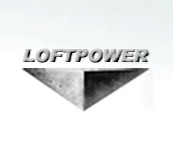
“中国创意文化产业最佳园区奖”、“国家级科技企业孵化器”、“… [ 详细 ]
- 徐小平和罗振宇投资Papi酱
- 微信公号名称乱象如何破
- 文化创意产业:“眼球经济”有待司法“点睛”
- 市场关注:艺术品市场面临“结构性坍塌”风险
外国律师眼中的中国外观设计专利
本文是由一位有着美国知识产权司法实践经验的在台湾注册的律师所写,文章对中国专利法的理解可能存在一定的问题,例如认为外观设计不存在宽限期,但仍不失为一篇好的法律英语读物。
Design Patents in China: Applications, Infringement and Enforcement
中国外观设计专利的申请、侵权、维权
Design patents have been making the news. Last summer, Apple’s $1.05 billion verdict against Samsung was famously based, in part, on the finding that Samsung infringed Apple’s rounded-rectangle and edge-to-edge glass designs. Since then, Yamaha, Thule, Oakley, Nike and Spanx, to name just a few, have litigated in the U.S. over the design of headphones, ski racks, sunglasses, footwear and women’s undergarments. And just last month, former head of the USPTO, David Kappos, published an OpEd piece describing design as “the new frontier of intellectual property.”
外观设计专利最近引起了人们的关注。去年夏天,苹果和三星金额高达10.5亿美元的诉讼官司很大部分是基于苹果发现三星侵犯了苹果的“圆角矩形”和“无边界玻璃”外观设计。从那以后,雅马哈,拓乐,奥克利,耐克等众多公司在美国提起了关于耳机,雪橇架,遮阳镜,鞋类,内衣类外观设计的诉讼。就在上个月,前美国专利局局长大卫·卡波斯在一篇社论中提到外观设计专利“成为了知识产权的新趋势”。
Nothing has fundamentally changed about the nature of design patents. The first US design patent was granted in 1842. The Statue of Liberty, Coke bottle, Volkswagen Beatle, Stealth Bomber and Star Wars’ Yoda are all protected by design patents. Design patents have long played an important role in consumer electronics, automotive, apparel, jewelry, packaging and other industries.
外观设计的本质并没有发生任何改变。美国第一项外观设计专利权是在1842年授权的。自由女神像,可口可乐瓶,大众甲壳虫,隐形轰炸机,星球大战中的尤达等都受到了外观设计专利权的保护。外观设计专利权在很长时间里在消费类电子产品,服装,珠宝,包装等产品上发挥了巨大的作用。
But industrial design is becoming increasingly important, Mr. Kappos explains, because the increasing functionality of man-made devices brings with it increasing complexity, so innovative companies are constantly seeking superior designs, a convergence of form and function that helps make the complex simple and sets their companies apart; and protecting such designs is critical.
但工业设计变得越来越重要,卡波斯解释说这是因为人造设备的复杂性导致的它的功能的多样性,所以创新型公司追求更好的设计,在外观和功能上使复杂变得简单并且使公司的产品更加醒目;所以保护外观设计就显得至关重要。
While that explanation sounds reasonable, in China there are additional factors and – as always – the picture is complex and uncertain, but it is perfectly clear that companies doing business in China, from manufacturing to sales, should seriously consider the roles design patents can play with respect to brand protection, counterfeiting and unscrupulous business practices.
尽管这种解释很合理,但在中国往往会存在其他因素,虽然前景很复杂和不确定,但在中国的外国企业从产品的生产到销售,必须考虑外观设计专利权保护在商标保护,打击产品仿冒,和制止不道德的商业行为中所起的作用。
Explosion of Patents 迅猛增长的专利
To start with, it should be noted that China grants far more design patents than any other jurisdiction. According to WIPO statistics, Japan’s Patent Office led the world in design patent applications from the 1950’s through the 1990’s; Korea’s Intellectual Property Office and the USPTO have shown a steady upward trend; but starting about 2000, the number of design applications filed in China has skyrocketed, so China’s Intellectual Property Office (SIPO) now issues more design patents than the next twenty offices combined and ten times the volume of the USPTO.
首先,我们要指出,中国的外观设计专利权授权量世界第一。根据世界知识产权组织的数据,从20世纪50年代到20世纪90年代,日本的外观设计专利数量领先世界,韩国和美国一直在增长,但从2000年开始,中国的外观设计专利申请量迅猛增长,现在,中国的外观设计专利申请量比其余二十个国家的总和还要多并达到了美国的十倍。
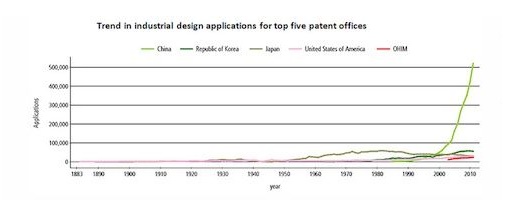
The vast majority of all design patents in China are granted to domestic applicants. Surely that is due, in part, to China’s indigenous innovation programs that provide cash bonuses and other financial incentives for the filing of patents and have been blamed for rewarding quantity at the expense of quality.
大部分的中国外观设计专利申请为国内申请。这主要是因为中国的创新计划对于申请专利进行奖励和其他的激励措施。
But perhaps there’s more to it than just that. More than one-third of all patent applications filed in China by domestic entities are for design patents, compared to just 10 percent for foreign applicants. Perhaps Chinese applicants have greater confidence than foreigners do that Chinese design patents, regardless of their quality or legitimacy, can give them an edge.
但是也许不仅仅是这些,超过三分之一的中国国内专利申请为外观设计专利申请,而涉外专利申请这个比例仅为百分之十。也许中国的申请者比外国申请者更有信心中国的外观设计专利能带来效益。
Applying for Design Patents 外观设计专利申请
The scope of a design patent in China is essentially the same as in the U.S., where protection is allowed for any new, original, ornamental design for an article of manufacture.
中国的外观设计专利的保护的范围和美国的保护范围大体一样,都是保护任何新的对于产品的外观所做的设计。
China employs an absolute novelty standard, and includes no grace period, so prior use or publication anywhere in the world will render the design un-patentable. In theory, one may not patent a design that is merely an aggregate of two or more prior designs or design features and the design must be strictly ornamental, not functional, although courts sometimes appear to overlook those requirements. Unlike the U.S., graphical user interface (GUI) designs – one of the three design patents found to be infringed in the Apple/Samsung case – may not be protected by design patents in China.
中国引进了一种全新的标准,并且没有宽限期,所以任何的在先使用和都会破坏外观设计的新颖性。从理论上说,一件外观设计不能是两件或两件以上的外观设计的集合,并且外观设计必须是装饰性的不能是功能性的,尽管很多时候法院会忽略这个标准。另外与美国不同的是,中国的外观设计不保护图形用户界面,而图形用户界面正是苹果和三星侵权案中涉及到的三个外观设计专利权中的一个。
However, the biggest difference between design patents in the U.S. and China is that in the U.S. design patens must pass a substantive examination, including a review of obviousness and prior art, but in China only a cursory examination is required, which looks into whether the application has been completed properly, drawings and power of attorney are attached, and the like.
但实际上中国和美国的外观设计专利权的最大的不同在于美国的外观设计专利权需要经过实质审查,包括审查创造性和新颖性,但在中国仅仅需要初步审查,审查外观设计申请是否符合规定等等。
The application must include either drawings or photographs of the design, along with a brief explanation used to interpret the drawings or photos and to indicate the essential portion of the design. Unlike the U.S. and other countries, in China the drawings may not include shading or broken lines to indicate non-essential features, so it may be prudent to eliminate non-essential features from the drawings to the extent possible.
外观设计申请文件包括外观设计的照片或图片,照片和用于对外观设计进行描述的简要说明。与美国不同的是,中国的外观设计的图片不能包括用于描述不必要部分的阴影线和断线,所以在中国申请外观设计专利时必须谨慎的将阴影线和断线去掉。
Test for Infringement 侵权测试
The test for infringement in the U.S., as expressed by the Supreme Court and affirmed by the Federal Circuit in Egyptian Goddess v. Swisa, is whether an “ordinary observer” (as opposed to an expert) familiar with the prior art, would be deceived into thinking the accused design was the same as the patented design. The Federal Circuit has explained further, in Contessa Food Products v. Conagra, that the overall features of an accused product must be compared to the patented design as a whole, as depicted in all of the drawings.
在美国,外观设计的侵权标准,是在Egyptian Goddess与Swisa的诉讼案中,由最高法院提出并由联邦巡回法庭确认的“熟悉本领域现有设计的一般消费者(而不是专家)会不会将该设计误认为与现有外观设计专利相同的设计。在Contessa Food Products 与Conagra的诉讼案中,联邦巡回法庭对该原则作了进一步解释,在涉案产品与现有的外观设计专利进行对比时,必须将涉案产品作为一个整体与现有外观设计作比较,并考虑涉案产品的全部特征和现有专利文件中全部特片描述的特征。
China’s test is roughly equivalent. The courts inquire whether an “ordinary consumer,” familiar with the prior art and looking at the patented design as a whole, rather than focusing on minor differences, would find the two designs confusingly similar. Admittedly, even in the U.S. a fair amount of subjectivity is involved in determining when there is too much similarity – it’s more of an art than a science – but, in China the outcome seems especially uncertain.
中国的判断标准大致相同。法院询问熟悉现有设计的“一般消费者”,并将已授权外观设计专利看成一个整体,在对比过程中不考虑产品的内部特征,在中国往往很难确定两件设计的相似度。必须承认,即使在美国,大量的案件也纠结于确定两件专利是否有较大的相似性,但在中国,相似性的判定更加不确定。
In one case, Fiat sued the Great Wall Motor Company for producing a car that bore a striking resemblance to Fiat’s Chinese design patent. Fiat had already won a verdict against Great Wall in Italy, based on the same facts and an EU design patent, with the Italian court finding Great Wall essentially copied Fiat’s design and just substituted a different front end on its car. The Chinese courts found otherwise, ruling Great Wall did not infringe, due to minor differences that outweighed the general similarities.
举一个案例,菲亚特起诉长城汽车公司生产的一款汽车与菲亚特的一项中国外观设计专利相似。在这之前,菲亚特在意大利已经以相同的事实并依据一项欧洲外观设计专利起诉了菲亚特并获得了胜诉,意大利法院认定长城抄袭了菲亚特的设计并仅仅在其车身上添加了一个不同的车尾。中国法院以“在存在主要区别的情况下,可以不考虑一般的相似性”为理由认定长城汽车公司不侵权。
[Note: Several photos of accused designs and prior designs are shown below for reference. Of course, the proper test employed by the courts is a comparison of the accused product and the design patent drawings or photos.]
[注释:下面展示几张涉案设计和在先设计的图片。当然,合适的判别方法是将涉案产品和外观设计图片和照片进行对此 。]
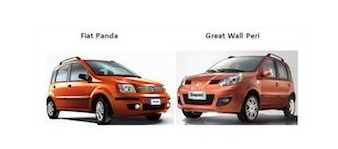
Similarly, in Honda v. The Patent Reexamination Board, the Supreme People’s Court examined a Chinese company’s SUV to decide if it infringed Honda’s design patent and found the ordinary consumer wouldn’t be confused by overall visual similarity due to minor differences between two designs. Although the Laibao SRV closely resembles Honda’s CR-V, the court found differences in the headlamps and side windows were sufficient to distinguish between the two designs.
相似地,在本田与中国专利复审委员会的诉讼案中,最高人民法院认定中国一家公司的SUV没有侵犯本田的外观设计专利权,理由是一般消费者还是可以分辨这两种产品。虽然莱宝抄袭了本田的设计,但法院认定两家公司的产品在前灯和车窗上存在较大差异。
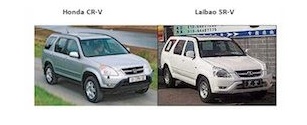
On the other hand, when German bus-maker Neoplan sued a competitor for infringing its Chinese design patent, the Beijing court chose to disregard minor differences, finding infringement and awarding Neoplan over $3 million in damages, based on similarities between the two overall designs. Unfortunately for Neoplan, the defendant appealed the decision and then succeeded in invalidating the patent based on Neoplan having published the design in Germany prior to applying for the patent in China.
但是在德国巴士车厂商尼奥普兰起诉竞争对手侵犯其中国外观设计专利权的案件中,北京法院没有采用主要差异原则,以两项产品有相似性为依据判尼奥普兰的竞争对手侵权并赔偿300万美元。但不幸的是,尼奥普兰的竞争对手在其后以尼奥普兰为申请中国专利而在德国提前公开了其设计为依据成功地将尼奥普兰的外观设计专利无效。
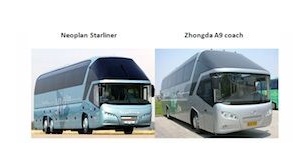
Is Enforcement Possible in China? 可以在中国执行吗?
Some foreigners may be reluctant to patent their designs in China, because they fear the risks of bias, corruption and incompetence may render enforcement of their rights too uncertain, so the costs will likely exceed the benefits. Such fears are not wholly unjustified, but China’s legal system is improving rapidly and many foreign companies have successfully protected and enforced their intellectual property rights in China.
很多国外厂商十分不情愿在中国申请外观设计专利,因为他们害怕会有歧视,腐败,和处理不当使得他们的权利保护处于不确定的状态,从而使他们得不偿失。这些担心不是没有道理,但是中国的司法系统在迅速地发展并且一些外国公司成功地在中国实施了他们的知识产权保护。
Motorola, Osram, Sony, Siemens, Kenwood, Bridgestone and Pfizer have all won patent lawsuits in China. In the design case described above, Neoplan won a $3 million verdict (though it was overturned on appeal). Apple is just one of many companies that have sought comprehensive design patent protection in China, including for the design of its stores (also protected by design patents in the U.S.).
摩托罗拉,欧司朗,索尼,西门子,健伍,普利司通,辉瑞都已经在中国赢得了专利诉讼案件。在外观设计领域,尼奥普兰赢得了300万的诉讼(尽管后来其专利被无效)。苹果是在中国寻求有效的知识产权保护的公司之一,苹果还为其门店设置了知识产权保护(苹果在美国也为其门店设置了知识产权保护)。
While damage awards tend to be smaller across the board in China, infringement of a design patent could, in theory, result in a larger damage award in China, as in the U.S., because both countries allow for recovery of lost profits for infringement of a design patent; not just reasonable royalties. Injunctive relief may also be available and, unlike the U.S., in China one may enforce intellectual property rights through the courts or by filing a complaint with the local administrative office. Damages are unavailable through administrative enforcement, but an accused party may be fined and have the infringing goods seized. Of course, when seeking local administrative relief, it is especially critical to work with an experienced local lawyer, who knows not just the procedures but the people.
在中国,侵权赔偿可能会较低,从理论上来讲,在中国侵犯外观设计专利的赔偿可能会很高,因为中国和美国一样,都采用损失的利润来确定赔偿额。在中国也可以采用强制救济,但在中国遇到侵权时可以去法院起诉也可以去当地的行政部门进行举报。行政救济的赔偿一般不高,但会进行罚款并扣押侵权商品。当然,寻求行政救济时,最好选择一名既懂相关程序又在当地拥有广泛人脉的律师。
Finally, if you don’t register your designs in China there’s a good chance a Chinese company will and you may be forced to pay a toll for use of your own design. U.S., Japanese and Korean auto-makers have repeatedly accused Chinese companies of stealing their designs, only to find the accused patented the designs first in China, in some cases based on models being sold first by the accusers in the U.S. (before 2009, prior use outside of China did not conflict with China’s novelty requirement).
如果你不在中国申请设计专利,很有可能中国公司剽窃你的设计而你最后要为使用自己的设计付费。美国,日本和韩国的汽车制造公司多次起诉中国的汽车制造厂商剽窃他们的设计,但最终发现这些公司已经就这些设计申请了中国的外观设计专利,在一些情况下他们是在美国销售的产品中得到的这些设计的样品(在2009年以前,国外的使用公开不会破坏外观设计的新颖性)。
Or take the case of Volkswagen and its Chinese partner First Automobile Works (FAW). It was reported last year that VW was investigating whether FAW was preparing to use technology stolen from VW to manufacture its own-brand vehicles, which FAW intended to export to Russia. Or the incident with iPhone 5, when Apple was preparing to launch its product, but GooPhone, a notorious Hong Kong maker of knock-offs, claimed it had patented the design first and would sue Apple if it dared to sell the real thing in China.
以大众和大众的合作伙伴一汽的案例为例。据报道称大众去年调查一汽是否准备将其从大众剽窃的技术用于其自主品牌的汽车并将其出口到俄罗斯。以及iphone5的例子,当苹果准备在中国销售其产品时,一家名为谷峰的香港手机制造商宣称其已经在中国获得了外观设计专利权并且如果苹果在中国销售其产品该公司就会将苹果告上法庭。
These are the types of cases where foreign companies likely regret that they didn’t patent their designs early in China.
这些都是那些外国公司后悔没有早在中国申请外观设计专利的例子。
Conclusion 结论
For the company that does business in China, manufacturing or selling products whose overall appearance or particular features have innovative designs that provide competitive advantage, it’s hard to imagine a reasonable justification for not seeking design patent protection.
对于那些在中国进行贸易,生产或销售其外观或者特殊特性有市场竞争力的企业,很难想到除了申请外观设计专利以外其他的保护自己权益的方法。
Due to the absence of substantive examination, the application process is relatively cheap and fast. While the term of protection is just 10 years, amendments to China’s Patent Act are being considered that will likely increase the term to 15 years, to bring China into compliance with the Hague Agreement concerning International Registration of Industrial Designs (Hague Agreement).
因为中国的外观设计专利申请不需要实质审查,申请过程简单并且费用低廉。但外观设计的保护期只有十年,据称中国为了和海牙条约保持一致,正在考虑修改专利法将外观设计专利权的保护期延长至15年。
It is generally prudent to patent not just the overall design for the entire product, but the designs of separate features and components, in order to protect against both cherry-picking infringers who seek to produce a hybrid design and companies that seek to copy only portions of the design in order to manufacture illegitimate spare parts.
一般来说,不对产品全体申请外观设计专利,而是为了防止那些坐享其成的厂家生产与自己产品部分相似的产品和只仿制产品某一部分的厂家是非常明智的。
Eventually it will be simple to obtain design protection worldwide pursuant to the terms of the Hague Agreement. The U.S. signed legislation last year that should come into effect about the end of 2013, to implement the Agreement. China will take longer, but they too will eventually implement the Agreement. When that time comes, it will be possible to obtain patent protection for up to 100 designs (in the same classification) in any jurisdiction that is a member of the Agreement, based on a single application and payment of the corresponding fees.
最后依照海牙公约,获得全球范围的外观设计专利权变得容易了。美国去年签署了法规来确认美国实施海牙公约中的条款,该公约于今年生效。中国可能还需要一段时间,但最终也会实施该公约。到那时,只需要提交申请并交纳一定的费用就可以在海牙公约的任何一个成员国内获得多达一百项外观设计专利(在同一类别)。
For now, until the Hague Agreement takes effect in China, one must file directly in China to protect ones design there. Make sure to file early, though, and keep the design confidential in the meantime, because China’s patent law requires absolute novelty and patent protection is only as strong as the patent.
在海牙公约在中国实施之前,必须到中国申请才能获得中国的外观设计专利权。要确保提早申请,因为中国的专利法要求完全的新颖性,并且在中国一项专利越稳定,其能收到的保护就越强。
Written by Chris Neumeyer
Managing Partner of Asia Law
永不停止对证据的挖掘;永不停止对法律的专研;永不停止对最佳法律方案的探究。

